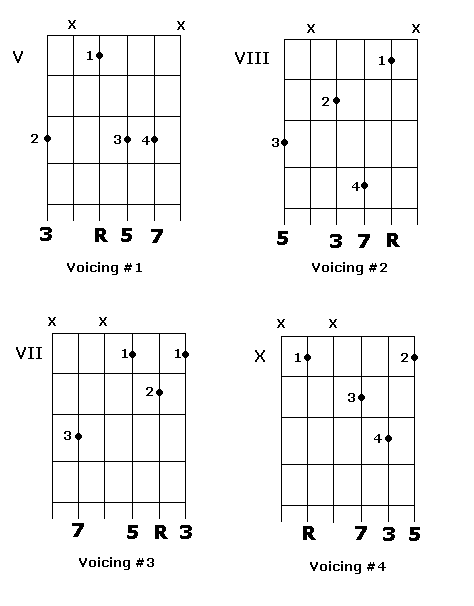Drop 3 Chord Voicings
Introduction:
In this lesson I present drop 3 chord voicings. The approach to constructing drop 3's is basically
the same as it is for drop 2's - we just drop the third note from the top of a closely packed
7th chord instead of the second as in drop 2 construction.
Drop 3 Theory:
Let's take a look at a G maj.7 chord in closed voicings in root position and all its inversions:

Diagram 1 - Four Voicings for a G maj.7 Chord
Now let's drop the third note from the top one octave in each voicing above to get
the following drop 3 voicings:

Diagram 2 - Drop 3 Voicings for a G maj.7 Chord
These structures yield the following fingerings on the guitar:
 Now, the rest of this lesson is up to you. That is, figure out all of the drop 3 fingerings for the 15
chord types presented in the previous lesson --> Maj.7,
min.7, Dom.7, min.7 (b5), and so on. Use the 4 voicings above for the Major 7th to get you started.
Before I send you on your way, however, the other thing worth mentioning is that drop 3 voicings fall
on two sets of strings:
Now, the rest of this lesson is up to you. That is, figure out all of the drop 3 fingerings for the 15
chord types presented in the previous lesson --> Maj.7,
min.7, Dom.7, min.7 (b5), and so on. Use the 4 voicings above for the Major 7th to get you started.
Before I send you on your way, however, the other thing worth mentioning is that drop 3 voicings fall
on two sets of strings:
-
6, 4, 3, 2 -
[ a "bottom" set with bass notes on the 6th string ]
-
5, 3, 2, 1 -
[ a "top" set with bass notes on the 5th string ]
What this means is that for each chord type (maj.7, min.7, etc.) you have 8 patterns, 4 on the "bottom" set
and 4 on the "top". This turns out to be 1/3 less the number of fingerings to figure out compared
to the drop 2 family of voicings, but that's still plenty of chords, probably more than you would
ever want to play.
Good luck hunting and try to incorporate some of these chord shapes into your music/playing.



